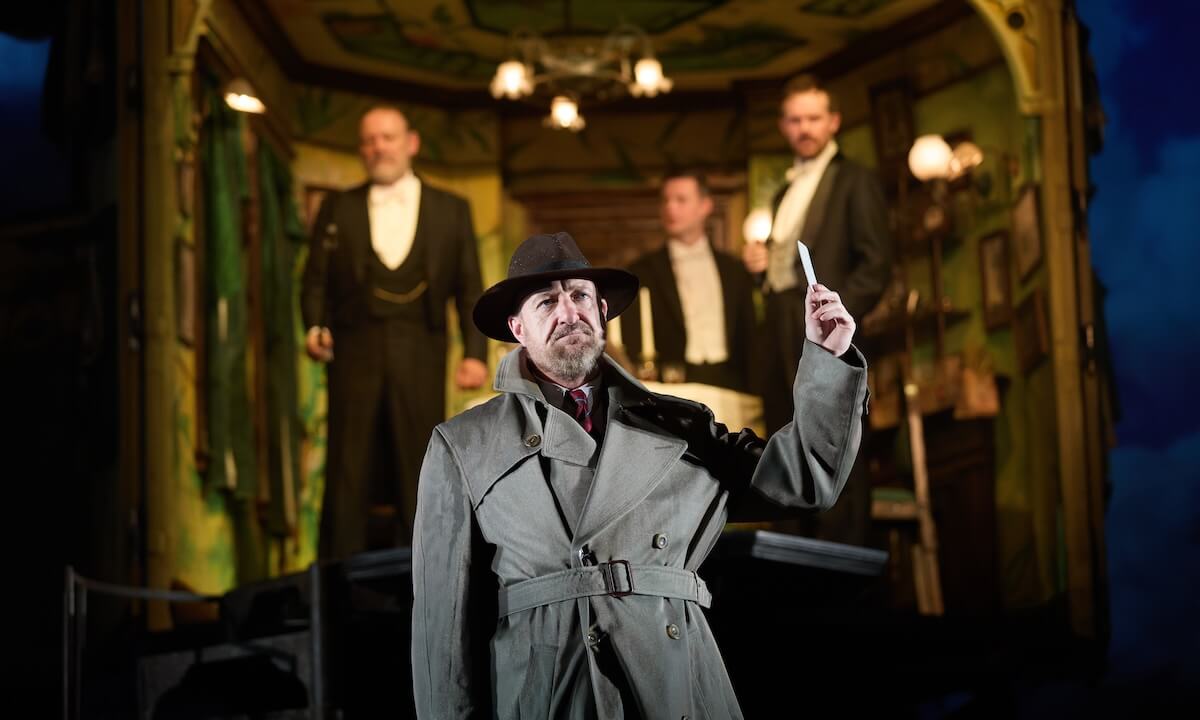Writer: J B Priestley
Director: Stephen Daldry
Arriving at The Alexandra, one can’t help but notice that the foyer is flooded with teenagers (and the  occasional frazzled-looking schoolteacher). This is unsurprising, really, given that An Inspector Calls has been a staple of the GCSE syllabus since at least the 1990s. Although the world has changed rather a lot since J.B. Priestley debuted the play in 1944, his message about the importance of social responsibility, accepting culpability for our actions and learning from them, remains just as significant today.
occasional frazzled-looking schoolteacher). This is unsurprising, really, given that An Inspector Calls has been a staple of the GCSE syllabus since at least the 1990s. Although the world has changed rather a lot since J.B. Priestley debuted the play in 1944, his message about the importance of social responsibility, accepting culpability for our actions and learning from them, remains just as significant today.
The play sees a wealthy and frivolous Birling family celebrating the engagement of their daughter Sheila to the equally well-off Gerald Croft. However, the celebrations are short-lived when they are interrupted by the arrival of a mysterious stranger. The man, introducing himself as Inspector Goole, begins to question each member of the family in turn about their connections to Eva Smith, a young woman who committed suicide earlier that day. As revelations unfold and secrets come to light, the family are faced with the irrefutable fact that their actions have an impact on the people around them.
The members of the Birling family are instantly unlikeable, snubbing the inspector as they brush off his questions and downplay their part in the tragedy. There are times when the acting can feel over-the-top, with several characters coming off like crass caricatures, but there are still several standout performances.
As Mr and Mrs Birling, Jeffrey Harmer and Jackie Morrison neatly capture the characters’ pompous and condescending attitudes. Whilst as their son Eric, George Rowlands confidently plays the role of a spoiled and rather naïve young man, who starts to show some signs of remorse as time goes on, but it is a case of too little, too late. Tom Chapman’s turn as Gerald is particularly enjoyable. There is a flicker of compassion in his portrayal as it becomes clear that he once cared for Eva. However, this moment of reflection is soon taken back, as he departs briefly and returns even more self-important than before.
Tim Treloar is enigmatic and compelling as the titular inspector. His portrayal is wry, accusatory and sardonic, peppered with moments of deep rage. He has a down-to-earth quality that counteracts the airs and graces of the family, particularly when he delivers the sobering line “We don’t live alone. We are members of one body. We are responsible for each other.”. Even now in 2025, the words feel raw and resonant, particularly given the rapidly changing global political landscape, and it is a stark reminder that Priestley’s overarching message is still relevant today.
Another stand-out performance comes from Leona Allen as Sheila, the daughter of the Birling family. She starts out just as dismissive as her parents, vapid as well as openly rude and mocking towards both Eva and the inspector. Yet as the story unfolds, she undergoes a striking transformation. Confronted with the weight of her actions, she becomes increasingly self-aware and shows hidden depths and humanity. Allen navigates the shift in personality with ease, and makes the audience switch from detesting to admiring Sheila.
In a very character-driven piece, it feels unusual to have such an extravagant set: at times, it feels as though that detracts, rather than adds to the play. All too often, it feels as though in his direction, Daldry favours style over substance. The show opens with a young boy playing with the curtain before it rises, and he remains present on stage throughout the play, but is never addressed. Those unfamiliar with the text are left to question what his role is.
Also, presumably due to staging constraints, the outer façade of the Birling house is comically small and out of proportion. The actors must duck to get through the front door, and when glimpsed through the windows, their legs take up most of the ground-floor, whilst their heads bob around the first-floor windows. It appears bizarre and is rather distracting, taking attention away from the story. Also, at this performance, it was difficult to hear the actors when they were inside the house façade. In the cacophony of voices, a lot of the lines were lost, and it made for a confusing start to the show.
The overall setting is perplexing, as the majority of the scenes appear to take place inside the house but simultaneously also on the cobbled street outside. At one point, Treloar’s Inspector moved to the upper circle of The Alexandra, without explanation. This all makes it difficult to connect with the sense of place. Potentially, this is a deliberate decision to highlight the themes of the play, such as the public airing of the Birling family’s dirty secrets, but it feels jarring, as if the characters are forced onto the street because there isn’t enough room in the house, as though the set isn’t suitable for purpose.
That said, it is undoubtedly the overall spectacle that has kept this production a mainstay on stages around the UK. Elements of Ian MacNeil’s set design are breathtaking, from the downpouring of rain to the violent collapsing of the house, representing the family’s deterioration. The production feels very cinematic and proved popular with its young audiences, judging by the reactions from nearby students; there were audible gasps as the house crashed forward, exclamations at a carefully choreographed fight scene, and rapturous applause at its finale. The production would certainly be a memorable introduction to theatre, and hopefully one that will inspire its young audiences to become regular theatregoers. An Inspector Calls is a show worth watching, if only for its formidable reputation and the important message it bears.
Runs until 10 May 2025 and on tour
